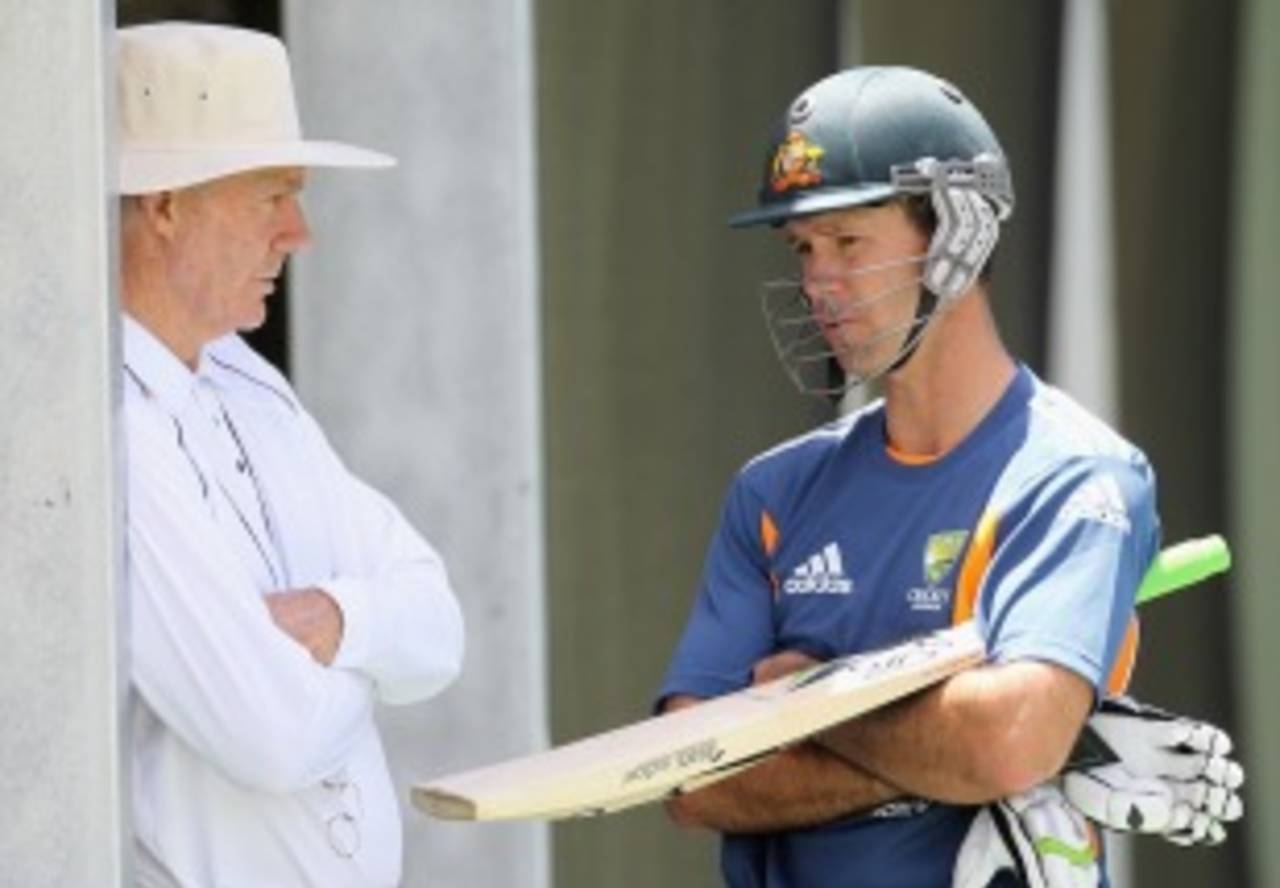A time for sparrow’s feet
People say baggy green caps are never given away lightly
Christian Ryan
25-Feb-2013

Greg Chappell has an eye for talent and Ricky Ponting needs more of it in his Test side • Getty Images
People say baggy green caps are never given away lightly. It’s a myth. Budding baggy green wearers, you hear it said, must first conjure a rainbow of runs or a thunderclap of wickets. That’s bollocks. Mark Cameron, Phil Hughes, Mitchell Starc, Usman Khawaja and Steve O’Keefe have not done enough to be considered compelling baggy green candidates. So goes the logic. The logic is bollocks built on a myth and it is holding Australia’s cricket back.
What makes a young cricketer compelling is not what a scorebook tells you but what the eyes see. One canny Australian selector, John Benaud, once described another, Lawrie Sawle, like so: “The skin at the edges of his eyes and mouth is sparrow-footed, creased in the squint of assessment, concentration…” Andrew Hilditch, David Boon and Jamie Cox crouched behind the netting at Australian team practice, that ain’t.
In Mark Cameron the eyes see a right-armer, lively pace, whose close-in angle and sideways movement gives batsmen’s techniques a tense, prolonged going-over. Phil Hughes is a left-hander whose technique has more holes than a colander but is underpinned by a kitchen sink – a kitchen sink that he throws at anything wide of off stump. Survive till the drinks break and he’s 65 not out. Cricketers like these two make good teams great. Somehow an ordinary Australian team aspiring merely to be half decent cannot find a place for them.
It makes you wonder what Australian cricket’s most influential sets of eyes – those belonging to Messrs Hilditch, Boon, Cox – are looking for. We have wondered this before. Wondering what drives Digger and Co’s thinking has become a pseudo-national pastime. It is, alas, a moot kind of wondering, for these three’s eyes are not open for dazzling by a pretty cover drive, or the perfect outswinger. Rather, they are black-digits-on-white-paper fellows. They do not ask: how? They ask: how many? Every selector asks this question. The wise ones know it is not the only question.
Some quarter of a century ago, Australia’s selectors laid the foundations for a dynasty by picking then sticking with a carefully identified handful. This handful had reasonable form, nothing more, to recommend them. But they all looked sort of game. The selection criterion was something less tangible than black digits on white paper – something more to do with personality. The selectors’ eyes saw something.
David Boon – the same David Boon, as irony would have it – won his baggy green cap on the back of two hundreds in his previous 19 first-class innings. Geoff Marsh had hit two in 17; Steve Waugh two in 16. Debutant fast bowler Merv Hughes sported a blow-your-house-down moustache but had blown no actual houses down: just a solitary five-wicket haul in five seasons. Craig McDermott, too young for moustaches, and possibly even for shaving, boasted one five-for in a couple of half seasons.
Other brief yet telling contributors were less obvious selections still. Offspinner Peter Taylor was plucked from the deepest backblocks of statistical nowheresville: Northern District Cricket Club. He had, however, nine months earlier, and seemingly unnoticed, bowled tidily on the fourth afternoon of a Sheffield Shield final while Queensland’s batsmen were busy setting up a declaration target. A selector, Greg Chappell, noticed. Chappell trusted his eyes. Chappell’s fellow selectors trusted Chappell’s eyes. Two of them had barely seen or heard of Peter Taylor. Yet pick Peter Taylor they did. Peter Taylor won Australia that Test match.
“When the need arose for a spin bowler,” Chappell explained many years later, “his was the name that came to mind. His technique was good. His temperament looked good. He just seemed a fairly cool customer.”
Those are sound reasons for picking any cricketer. And Chappell, after a couple of decades’ hiatus, is helping pick Australian cricketers once again. Here are the names of three more fairly cool-seeming customers: Cameron, Hughes and (when fit) Starc. Them and two or three others should do the trick. There’s an Ashes series to win, and not a moment to lose. And England’s attack – no Stuart Broad, an ungiving Perth surface awaiting Graeme Swann and his off-breaks – suddenly looks a little riper for a battering than it did.
People say swapping five players mid-series equates to panic. But that’s more myth-making bollocks. Hilditch and company have had their conservative, insouciant, keep-both-eyes-on-the-scorebook go. Over to you, Greg Chappell.
Christian Ryan is a writer based in Melbourne. He is the author of Golden Boy: Kim Hughes and the Bad Old Days of Australian Cricket and, most recently Australia: Story of a Cricket Country